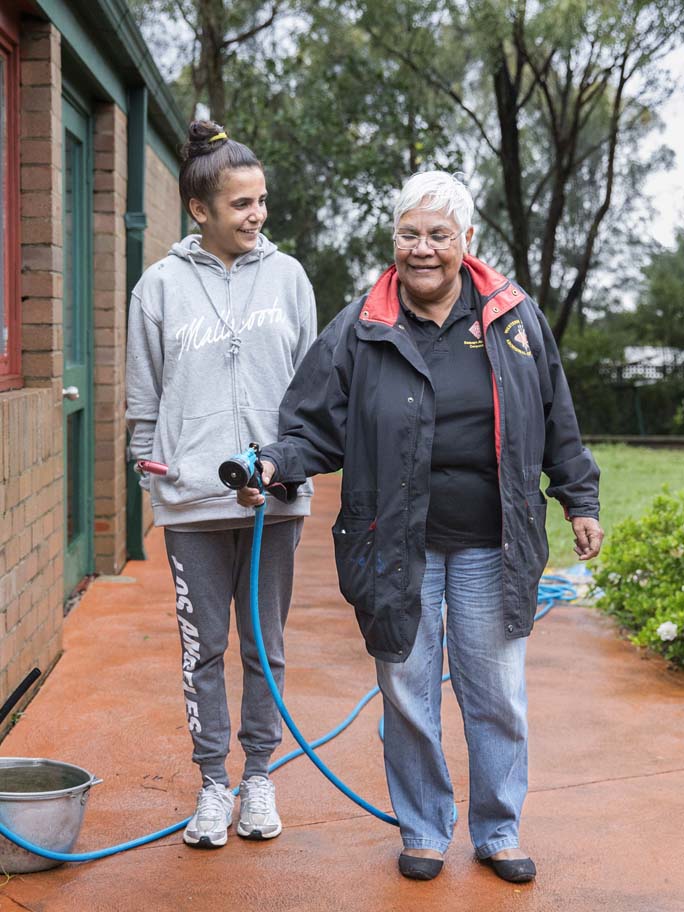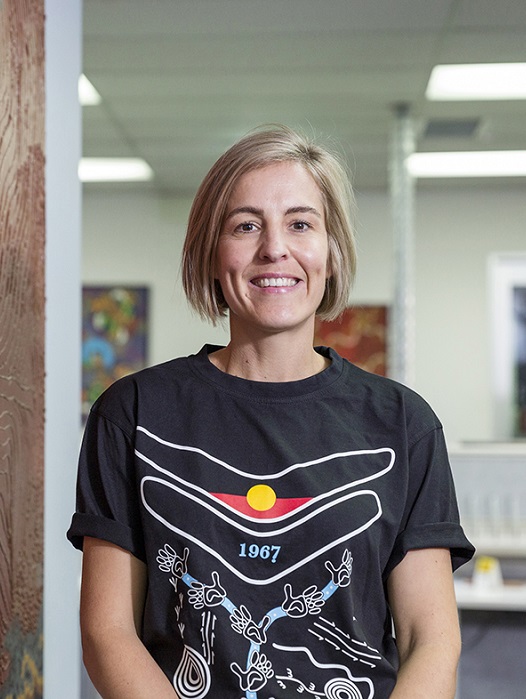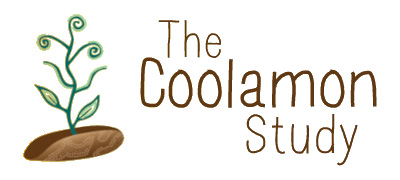Background: Why the Ironbark project?
Aboriginal Elders are the keepers of our cultural knowledge, they are the educators in our communities teaching our young, supporting and maintaining connection to country and an integral part of Aboriginal culture.
Many older Aboriginal people are also the caregivers of their grandchildren and are seen as mothers and fathers rather than grandparents.
As the Aboriginal population ages, it is important to provide programs that meets their needs and supports older Aboriginal people to continue their important role in community.
The Ironbark: Standing Strong and Tall program is a falls prevention program developed in partnership with Aboriginal communities in NSW. It was then tested with six communities and the evaluation found:
- 98 Aboriginal people registered for the program, ages ranging from 40-90 years old, mostly women (53 female participants, 69%).
- The program significantly improved strength and balance
- There was a significant average decrease of in average Body Mass Index
- There was a noticeable increase in participants becoming involved with social activities and outings, including walking groups.
All participants enjoyed the program, and all were willing to recommend the program to others. The most popular element of the program was the Yarning Circles.
The Ironbark trial has now been funded by the National Health and Medical Research Council to test if the Ironbark program prevents falls, and improves the health and wellbeing of older Aboriginal people.
We also aim to contribute to the evidence that community based, Aboriginal led programs are culturally appropriate and acceptable to Aboriginal people across other states, and are cost effective.
For further information:
First Nation Elders’ perspectives on healthy ageing in NSW, Australia article

“Well, the program was actually more then what I thought it would be. It was very good. The information was great combined with the Yarning Circle. The people who come feel like a family now, it has helped with loneliness and death within our group. Each of us had each other it has enhanced our lives. We hope to keep coming so we can have our yarning and exercises.”
IRONBARK PROGRAM PARTICIPANT
A disjuncture of world views: manifestation in burns care for Aboriginal and Torres Strait Islander children in Australia - Sarah Fraser
Background
Burns injury is a significant burden across Australia. Aboriginal and Torres Strait Islander children experience these injuries at disproportionally higher rates than non-Indigenous children. Aboriginal and Torres Strait Islander children also have longer lengths of stay in tertiary healthcare when compared with other Australian children. Despite these clear health inequities, it is unclear what guides burns care for Aboriginal and Torres Strait Islander children, nor how burns care is delivered and structured, or if it meets the needs of this population.
Methods
Interface research methodology incorporating both Indigenous and Western biomedical knowledges guided the research. The research sought to explore how burns care is delivered, with a focus on care for Aboriginal and Torres Strait Islander children and families. This study also investigated factors informing burns care and explored how clinicians in burns teams used guidance documents and if such documents were appropriate for care of Aboriginal and Torres Strait Islander children. Evidence for the use of telehealth for care of chronic conditions with Indigenous people was globally reviewed for cultural considerations.
International models of care for burns were critiqued for quality and cultural safety. Semi-structured interviews were conducted with 76 individuals in burns teams in six sites across Australia to investigate burns care. Interviews were audio recorded and transcribed. Data were firstly analysed using inductive thematic analysis. Secondary analysis comprised ecological modelling overlaid with a decolonising lens. A patient journey mapping tool was developed and tested to assess quality and cultural safety with family and healthcare professional data.
Results
Exploration of current burns care identified differences in care outcomes and a lack of clarity about how current burns care meets the needs of Aboriginal and Torres Strait Islander children and families. Telehealth as a modality of care was limited in improving access to healthcare for those families living in regional or remote locations. The cultural competency of telehealth remains unclear. Existing models of care for burns injury do not meet all aspects of quality or cultural safety. Overall, a disconnect between Western and Indigenous knowledges was found and is manifest in both Australia’s mainstream healthcare system and in the documents that inform burns care. Results from interviews with multidisciplinary burns team members showed burns care is informed by multiple factors, including evidence, resources and resourcing, decision-making processes and values and beliefs.
Imbalances of power and the perpetuation of colonisation, through hierarchal teams and the dominant use of the biomedical model, were evident throughout. The sole use of the biomedical model meant that equity in healthcare was limited with restricted capacity for the delivery of care based on needs other than those aligned with the biomedical model. This restricted capacity was echoed in the findings from a subset of multidisciplinary burns team interview data where multiple issues related to equity and equality in the delivery of burns care for Aboriginal and Torres Strait Islander children were identified. These included a limited understanding of the need to provide different care for Aboriginal and Torres Strait Islander children and families, and little or no use of reflexivity in practice. Lastly, the research has resulted in the development of a platform to better understand and assess quality and cultural safety in burns care through patient journey mapping.
Discussion
This work has established that the full potential of paediatric burns care in Australia is not realised for Aboriginal and Torres Strait Islander families accessing care. This has social economic and cultural ramifications for Aboriginal and Torres Strait Islander children and families seeking and not achieving best quality burns care. It was very clear from this research that there was dominant use of the Western biomedical model in the enactment of burns care. There was limited or no reflexivity evident in burns care for Aboriginal and Torres Strait Islander children and families, and limited understanding of equity and equality or the realisation that the Western biomedical paradigm will not solve everything for everyone.
There is however, an opening for the two different paradigms, Western biomedical and Aboriginal and Torres Strait Islander, to sit beside one another in burns care. The two knowledges might come together in the development of a new model of care for burns. Burns care at the interface of knowledges could be supported by healthcare professionals with skills to understand how these paradigms influence their practice and the resources and explicit guidance to inform such translation into care.
Biography - Sarah Fraser
Sarah a registered nurse and has a masters of nursing in child health and development. Sarah has worked in both the acute tertiary sector and in primary health care; specifically leading a team of clinical nurses engaged in care with Aboriginal infants and families.
Sarah’s interest in working with children and improving health care led to her recent PhD completion (March 2019) whereby she investigated quality and safety in the health care systems informing burn care for Aboriginal and Torres Strait Islander children across Australia. These skills, along with her knowledge and experience now inform the work she does for Member Services as Manager of the Quality Systems Team at the Aboriginal Health Council of South Australia and more broadly with and for Aboriginal people across South Australia.

